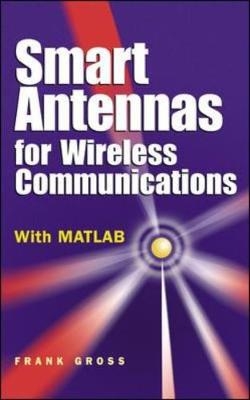
Smart Antennas for Wireless Communications
McGraw-Hill Professional (Verlag)
978-0-07-144789-8 (ISBN)
- Titel ist leider vergriffen;
keine Neuauflage - Artikel merken
Smart antennas boost the power of a wireless network, saving energy and money and greatly increasing the range of wireless broadband. Smart Antennas is a rigorous textbook on smart antenna design and deployment.
Frank Gross, Ph.D. is presently Senior Systems Engineer with Argon ST in Virginia. He was Associate Professor of Electrical Engineering at Florida A&M University. He previously served as Lead Engineer for the MITRE Corporation and as a Senior Research Engineer at the Georgia Tech Research Institute. Dr. Gross has authored more than 60 articles on electro-magnetics, radar, and sensing.
1. Introduction 1.1. What is a Smart Antenna? 1.2. Why Are Smart Antennas Emerging Now? 1.3. What are the Benefits of Smart Antennas? 1.4. Smart Antennas Involve Many Disciplines 1.5. Overview of the Book References 2. Fundamentals of Electromagnetic Fields 2.1. Maxwell’s Equations 2.2. The Helmholtz Wave Equation 2.3. Propagation in Rectangular Coordinates 2.4. Propagation in Spherical Coordinates 2.5. Electric Field Boundary Conditions 2.6. Magnetic Field Boundary Conditions 2.7. Planewave Reflection and Transmission Coefficients 2.7.1. Normal Incidence 2.7.2. Oblique Incidence 2.8. Propagation Over Flat Earth 2.9. Knife-Edge Diffraction References Problems 3. Antenna Fundamentals 3.1. Antenna Field Regions 3.2. Power Density 3.3. Radiation Intensity 3.4. Basic Antenna Nomenclature 3.4.1. Antenna Pattern 3.4.2. Antenna Boresight 3.4.3. Principal Plane Patterns 3.4.4. Beamwidth 3.4.5. Directivity 3.4.6. Beam Solid Angle 3.4.7. Gain 3.4.8. Effective Aperture 3.5. Friis Transmission Formula 3.6. Magnetic Vector Potential and the Far Field 3.7. Linear Antennas 3.7.1. Infinitesimal Dipole 3.7.2. Finite Length Dipole 3.8. Loop Antennas 3.8.1. Loop of Constant Phasor Current References Problems 4. Array Fundamentals 4.1. Linear Arrays 4.1.2. Two Element Array 4.1.3. Uniform N-Element Linear Array 4.1.2.1 Broadside Linear Array 4.1.2.2 End-Fire Linear Array 4.1.2.3 Beamsteered Linear Array 4.1.4. Uniform N-Element Linear Array Directivity 4.1.4.1. Broadside Array Maximum Directivity 4.1.4.2. End-Fire Array Maximum Directivity 4.1.4.3. Beamsteered Array Maximum Directivity 4.2. Array Weighting 4.2.2. Beamsteered and Weighted Arrays 4.3. Circular Arrays 4.3.2. Beamsteered Circular Arrays 4.4. Rectangular Planar Arrays 4.5. Fixed Beam Arrays 4.5.2. Butler Matrices 4.6. Fixed Sidelobe Canceling 4.7. Retrodirective Arrays References Problems 5. Principles of Random Variables and Processes 5.1. Definition of Random variables 5.2. Probability Density Functions 5.3. Expectation and Moments 5.4. Common probability density functions 5.5. Stationarity and ergodicity 5.6. Autocorrelation and power spectral density 5.7. Correlation matrix References Problems 6. Propagation Channel Characteristics 6.1. Flat Earth Model 6.2. Multipath Propagation Mechanisms 6.3. Propagation Channel Basics 6.3.1. Fading 6.3.2. Fast Fading Modeling 6.3.3. Channel Impulse Response 6.3.4. Power Delay Profile 6.3.5. Prediction of Power Delay Profiles 6.3.6. Power Angular Profile 6.3.7. Prediction of Angular Spread 6.3.8. Power Delay-Angular Profile 6.3.9. Channel Dispersion 6.3.10. Slow Fading Modeling 6.4. Improving Signal Quality 6.4.2. Equalization 6.4.3. Diversity 6.4.3.1. RAKE Receiver 6.4.4. Channel Coding 6.4.5. MIMO References Problems 7. Angle-of-Arrival Estimation 7.1. Fundamentals of Matrix Algebra 7.1.2. Vector Basics 7.1.3. Matrix Basics 7.2. Array Correlation Matrix 7.3 AOA Estimation Methods 7.3.1. Bartlett AOA Estimate 7.3.2. Capon AOA Estimate 7.3.3. Linear Prediction AOA Estimate 7.3.4. Maximum Entropy AOA Estimate 7.3.5. Pisarenko Harmonic Decomposition AOA Estimate 7.3.6. Min-Norm AOA Estimate 7.3.7. MUSIC AOA Estimate 7.3.8 Root-MUSIC AOA Estimate 7.3.9 ESPRIT AOA Estimate References Problems 8. Smart Antennas 8.1. Introduction 8.2. The Historical Development of “Smart Antennas” 8.3. Fixed Weight Beamforming Basics 8.3.1. Maximum Signal-to-Interference Ratio 8.3.2. Minimum Mean-Square Error 8.3.3. Maximum Likelihood 8.3.4. Minimum Variance 8.4. Adaptive Beamforming 8.4.1. Least Mean Squares 8.4.2. Sample Matrix Inversion 8.4.3. Recursive Least Squares 8.4.4. Constant Modulus 8.4.5. Least Squares Constant Modulus 8.4.6. Conjugate Gradient Method 8.4.7. Spreading Sequence Array Weights 8.4.7.1. Description of the New SDMA Receiver 8.4.7.2. Example using bi-phase chipping References Problems
| Erscheint lt. Verlag | 16.10.2005 |
|---|---|
| Reihe/Serie | Professional Engineering |
| Zusatzinfo | 100 Illustrations, unspecified |
| Sprache | englisch |
| Maße | 163 x 236 mm |
| Gewicht | 496 g |
| Themenwelt | Technik ► Elektrotechnik / Energietechnik |
| Technik ► Nachrichtentechnik | |
| ISBN-10 | 0-07-144789-X / 007144789X |
| ISBN-13 | 978-0-07-144789-8 / 9780071447898 |
| Zustand | Neuware |
| Haben Sie eine Frage zum Produkt? |
aus dem Bereich


